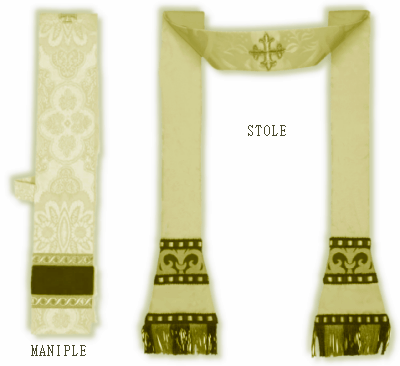I was reading a book called The Blessed Eucharist by Fr. Michael Muller, which I highly recommend, if you can find it anywhere. At the end of the book, Fr. Muller talks about the garments the priest wears and what they represent, which I found very interesting. They all mean something! It's fascinating how nothing in a traditional Catholic Church is meaningless; nothing is there just for the sake of extravagance. The architecture, the way the building is facing, and apparently, even clothes, are all full of beautiful significance. The priest, who is the representative of Christ, is dressed like Him:
The amice, a white cloth worn around the neck, which is no longer required in the Catholic Church unless the alb does not cover the priest's ordinary clothing, represents the handkerchief with which the men who seized Him blindfolded Our Lord when they were "covering His head and asking him: Which one hit you? Prophesy!" (Luke 22:64)
The alb "signifies the white robe which Herod put on our Savior in mockery." (The Blessed Eucharist, p. 255) "And Herod despised Him and put shining clothes on Him and sent Him back with his guards to Pilate. And Herod and Pilate became friends with each other on that same day, after having been at enmity before." (Luke 23:11-12)
The cincture, which is the rope around the waist of the priest in the picture of the alb, the maniple on the left arm, which you may not see very often because since Vatican II it is not used much, though the Church has never said not to use it, and the stole, the scarf-like garment a priest wears during Confession, which hangs around the neck and during Mass is crossed in the front, "represent the cords and strings with which Our Lord was bound, and by which He was dragged through the streets of Jerusalem." (The Blessed Eucharist)
"The chasuble, worn over all the others, signifies the scarlet robe in which He was arrayed when Pilate showed him to the people, saying, 'Behold the man!' " "Then the soldiers of the governor took Jesus to the residence and drew up all their battalion around him. And they stripped him and put a red mantle about him, and wove a wreath of thorns and put it on his head, and put a reed in its right hand, and knelt before him and mocked him, saying: Hail, King of the Jews." (Matthew 27: 27-29) "And they slapped him. And Pilate came out again and said to them: See, I am bringing him out to you, so that you may know that I find no fault in him. So Jesus came out, wearing the crown of thorns and the purple cloak. And Pilate said to them: Behold the man." (John 19:3-5)
I hope you found this as interesting as I did! It really is the "holy sacrifice" of the Mass. And just for kicks (the links go to pictures of the objects): "The altar, with its crucifix, represents Mount Calvary; the chalice signifies the Saviour's tomb; the paten, His tombstone; and the purifier (I have always heard this called a purificator, insert mine), with the pall and corporal, the linen cloths in which His Sacred Body was wrapped when it was laid in the tomb."
God bless!
Helen

.png)

.jpg)
No comments:
Post a Comment